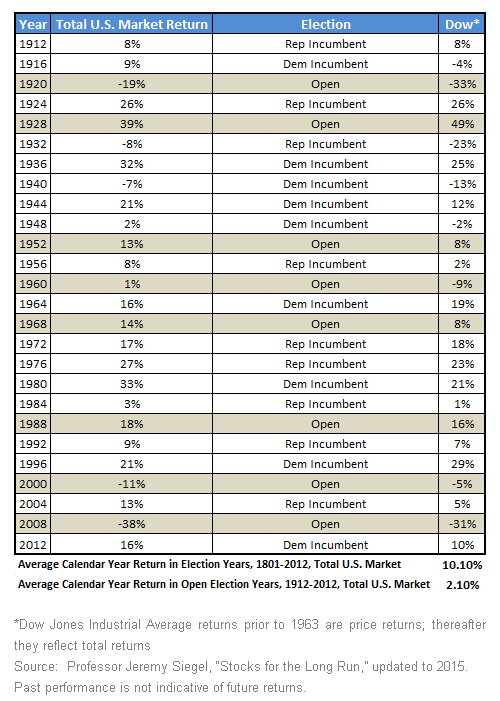With the World Series over and the fourth Republican primary debate scheduled for tonight, the reality that a new presidential election year is less than a year away is rapidly settling in.
Bull markets tend to climb a wall of worry, and next year’s “
open election,” where there is no incumbent in the race, may present a new obstacle for the stock market to overcome.
As I pointed out in an August blog on the night of the first republican debate, with grassroots voters in each party coalescing around nontraditional candidates, not only are the early poll results a signal of wider discontent in the electorate, they also widen the possible policy outcomes that could follow next November’s elections.
On the one hand, there is nothing particularly notable about presidential election years. We have had 54 of them back to 1800, and the total U.S. stock market has returned 10.1% on average in those calendar years. That is very close to the 9.7% average calendar year return between 1801 and 2014. However, in the last 100 years, the stock market has returned only 2.1% on average during open election years.
Of the eight open election years over the last century, the
Dow Jones Industrial Average has seen negative returns in 2008, 2000, 1960 and 1920. Put another way, the odds of a “down year,” which is typically one in four, rises to one in two in open election years over the past century, if you use the Dow as your proxy.
Table of U.S. Stock Market Returns in Presidential Election Results, 1912–2012

What explains the underperformance in open election years? One answer may be as simple as recent open election years having coincided with the end of business cycles. By 2000 and 2008, for example, the
Federal Funds Rate had already been raised above 5%. Similarly, the first year of a new presidential term is often the year when political capital is spent to make the hard choices required to govern. Sometimes that involves raising taxes or cutting the rate of future spending, both of which can impact consumer and business confidence and slow
gross domestic product (GDP) growth. But I suspect another part of the answer is that equity markets hate the uncertainty that accompanies open election years. Investors may prefer the challenge of overcoming policies they know and do not like rather than divining what future policy may be. The smartest course in such years may be to sit on the sidelines and wait until clarity emerges.
Compounding this is the fact that in 2017 the range of potential policy outcomes is wide ranging depending on who gets elected in 2016. Dividing up the spoils of victory very much depends on not just who sits in the White House but who runs the agencies and which leaders control Congress. The billions that get contributed to political campaigns are not the result of an outburst in patriotism during election years. More often than not, the fund-raising comes at a price, a political return on investment that takes the form of tax expenditures embedded in the tax code; pork barrel spending or government contracts; regulatory waivers or outright relief; and varying interpretations about how aggressively to implement or enforce existing laws. Assuming Republicans maintain control of the House and Senate, a Republican in the White House could result in a substantial shift in tax, energy, healthcare, regulatory and entitlement policy. On the other hand, a Democratic victory could mean more divided government and a political stalemate in Washington. Or, if bipartisan compromise does emerge, it could mean more intervention into the private economy and higher taxes to help finance programs and benefits for qualifying beneficiaries.
Conclusion
Given the range of potential outcomes in 2016, investors, consumers, business owners and executives may take a wait-and-see attitude in the coming months until greater clarity emerges later next year. Net–net such political uncertainty is, I believe, a negative for the U.S. equity market, creating an additional obstacle to overcome on the wall of worry.


 What explains the underperformance in open election years? One answer may be as simple as recent open election years having coincided with the end of business cycles. By 2000 and 2008, for example, the Federal Funds Rate had already been raised above 5%. Similarly, the first year of a new presidential term is often the year when political capital is spent to make the hard choices required to govern. Sometimes that involves raising taxes or cutting the rate of future spending, both of which can impact consumer and business confidence and slow gross domestic product (GDP) growth. But I suspect another part of the answer is that equity markets hate the uncertainty that accompanies open election years. Investors may prefer the challenge of overcoming policies they know and do not like rather than divining what future policy may be. The smartest course in such years may be to sit on the sidelines and wait until clarity emerges.
Compounding this is the fact that in 2017 the range of potential policy outcomes is wide ranging depending on who gets elected in 2016. Dividing up the spoils of victory very much depends on not just who sits in the White House but who runs the agencies and which leaders control Congress. The billions that get contributed to political campaigns are not the result of an outburst in patriotism during election years. More often than not, the fund-raising comes at a price, a political return on investment that takes the form of tax expenditures embedded in the tax code; pork barrel spending or government contracts; regulatory waivers or outright relief; and varying interpretations about how aggressively to implement or enforce existing laws. Assuming Republicans maintain control of the House and Senate, a Republican in the White House could result in a substantial shift in tax, energy, healthcare, regulatory and entitlement policy. On the other hand, a Democratic victory could mean more divided government and a political stalemate in Washington. Or, if bipartisan compromise does emerge, it could mean more intervention into the private economy and higher taxes to help finance programs and benefits for qualifying beneficiaries.
Conclusion
Given the range of potential outcomes in 2016, investors, consumers, business owners and executives may take a wait-and-see attitude in the coming months until greater clarity emerges later next year. Net–net such political uncertainty is, I believe, a negative for the U.S. equity market, creating an additional obstacle to overcome on the wall of worry.
What explains the underperformance in open election years? One answer may be as simple as recent open election years having coincided with the end of business cycles. By 2000 and 2008, for example, the Federal Funds Rate had already been raised above 5%. Similarly, the first year of a new presidential term is often the year when political capital is spent to make the hard choices required to govern. Sometimes that involves raising taxes or cutting the rate of future spending, both of which can impact consumer and business confidence and slow gross domestic product (GDP) growth. But I suspect another part of the answer is that equity markets hate the uncertainty that accompanies open election years. Investors may prefer the challenge of overcoming policies they know and do not like rather than divining what future policy may be. The smartest course in such years may be to sit on the sidelines and wait until clarity emerges.
Compounding this is the fact that in 2017 the range of potential policy outcomes is wide ranging depending on who gets elected in 2016. Dividing up the spoils of victory very much depends on not just who sits in the White House but who runs the agencies and which leaders control Congress. The billions that get contributed to political campaigns are not the result of an outburst in patriotism during election years. More often than not, the fund-raising comes at a price, a political return on investment that takes the form of tax expenditures embedded in the tax code; pork barrel spending or government contracts; regulatory waivers or outright relief; and varying interpretations about how aggressively to implement or enforce existing laws. Assuming Republicans maintain control of the House and Senate, a Republican in the White House could result in a substantial shift in tax, energy, healthcare, regulatory and entitlement policy. On the other hand, a Democratic victory could mean more divided government and a political stalemate in Washington. Or, if bipartisan compromise does emerge, it could mean more intervention into the private economy and higher taxes to help finance programs and benefits for qualifying beneficiaries.
Conclusion
Given the range of potential outcomes in 2016, investors, consumers, business owners and executives may take a wait-and-see attitude in the coming months until greater clarity emerges later next year. Net–net such political uncertainty is, I believe, a negative for the U.S. equity market, creating an additional obstacle to overcome on the wall of worry.


